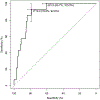Use of cross-reactive serological assays for detecting novel pathogens in wildlife: assessing an appropriate cutoff for henipavirus assays in African bats
- PMID: 23835034
- PMCID: PMC8796701
- DOI: 10.1016/j.jviromet.2013.06.030
Use of cross-reactive serological assays for detecting novel pathogens in wildlife: assessing an appropriate cutoff for henipavirus assays in African bats
Abstract
Reservoir hosts of novel pathogens are often identified or suspected as such on the basis of serological assay results, prior to the isolation of the pathogen itself. Serological assays might therefore be used outside of their original, validated scope in order to infer seroprevalences in reservoir host populations, until such time that specific diagnostic assays can be developed. This is particularly the case in wildlife disease research. The absence of positive and negative control samples and gold standard diagnostic assays presents challenges in determining an appropriate threshold, or 'cutoff', for the assay that enables differentiation between seronegative and seropositive individuals. Here, multiple methods were explored to determine an appropriate cutoff for a multiplexed microsphere assay that is used to detect henipavirus antibody binding in fruit bat plasma. These methods included calculating multiples of 'negative' control assay values, receiver operating characteristic curve analyses, and Bayesian mixture models to assess the distribution of assay outputs for classifying seropositive and seronegative individuals within different age classes. As for any diagnostic assay, the most appropriate cutoff determination method and value selected must be made according to the aims of the study. This study is presented as an example for others where reference samples, and assays that have been characterised previously, are absent.
Keywords: Eidolon helvum; Emerging diseases; HeV; Hendra virus; MCMC; MFI; Markov chain Monte Carlo; Microsphere binding assay; Multiplex; NiV; Nipah virus; ROC; Serology; median fluorescence intensity; receiver operating characteristic.
Copyright © 2013 The Authors. Published by Elsevier B.V. All rights reserved.
Figures




Comment in
-
Bat trait, genetic and pathogen data from large-scale investigations of African fruit bats, Eidolon helvum.Sci Data. 2016 Aug 1;3:160049. doi: 10.1038/sdata.2016.49. Sci Data. 2016. PMID: 27479120 Free PMC article.
References
-
- Baughman AL, Bisgard KM, Lynn F, Meade BD, 2006. Mixture model analysis for establishing a diagnostic cut-off point for pertussis antibody levels. Zoonoses Public Hlth. 25, 2994–3010. - PubMed
-
- Bossart KN, McEachern JA, Hickey AC, Choudhry V, Dimitrov DS, Eaton BT, Wang L-F, 2007. Neutralization assays for differential henipavirus serology using Bio-Plex Protein Array Systems. J Virol Methods. 142, 29–40. - PubMed
-
- Böhning D, Schlattmann P, Lindsay B, 1992. Computer-assisted analysis of mixtures (C.A.MAM): statistical algorithms. Biometrics. 48, 283–303. - PubMed
Publication types
MeSH terms
Substances
Grants and funding
LinkOut - more resources
Full Text Sources
Other Literature Sources
Research Materials

